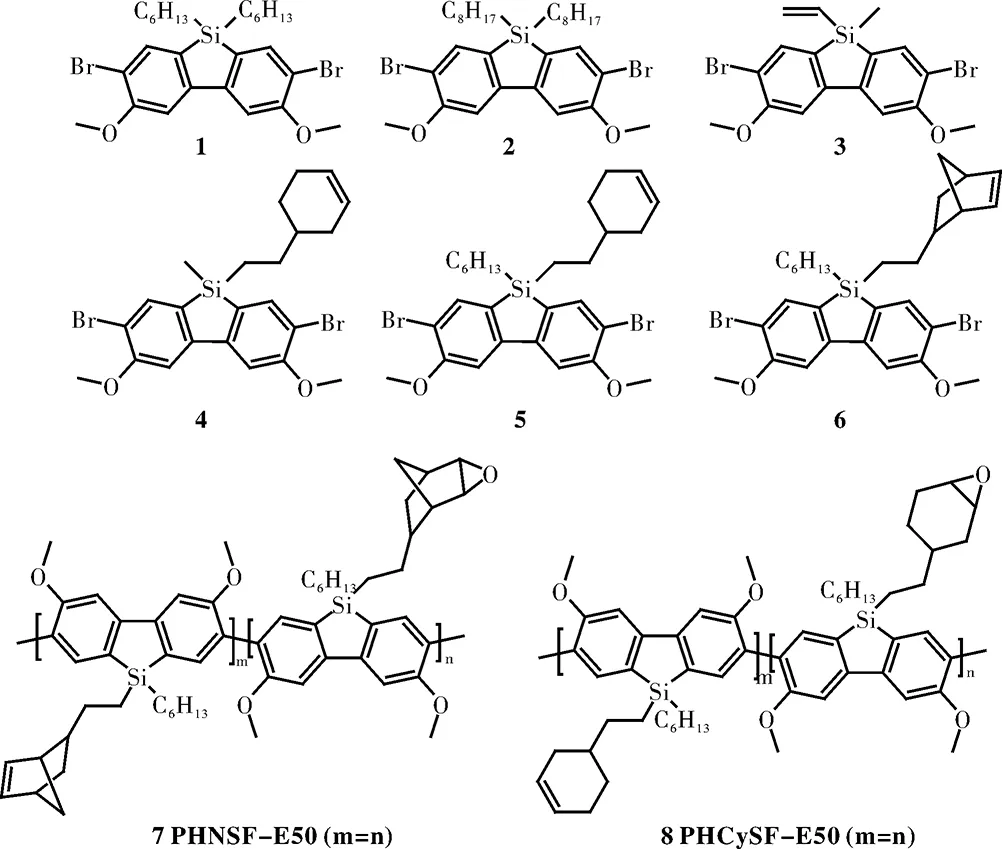二苯并噻咯类化合物的应用研究进展
李彦敏,李书宏
(北京工商大学理学院,北京 10048)
二苯并噻咯类化合物的应用研究进展
李彦敏,李书宏
(北京工商大学理学院,北京10048)
二苯并噻咯类化合物,将主族元素硅的特性与其本身的刚性共平面结构相结合,具有特殊的有机电致发光特性。噻咯环位于结构中心,硅原子的两个环外硅原子的两个环外σ*轨道与丁二烯部分的π*轨道产生σ*-π*共轭,可以有效降低最低未占有轨道(LUMO)的能量,提高电子亲和性和导电性,有利于电子的传输,本文着重对该类化合物在有机发光二极管、太阳能电池 或光伏电池、有机场效应晶体管及爆炸性物质检测等方面的研究进展。
硅桥联;二苯并噻咯;性质
硅桥联并环π共轭分子,以其特殊的刚性共平面结构避免了构造的无序性,较非并环结构母体增强,具有较强的荧光特性、高载流子传输效率等,同时主族元素硅的引入将结构与其轨道特性相结合,赋予此类化合物特殊的有机电致发光特性[1],并引起研究者们广泛的关注,其中二苯并噻咯(也称硅芴)便是研究最广泛的一类化合物。噻咯环位于其结构中心,硅原子的两个环外σ*轨道与丁二烯部分的π*轨道产生σ*-π*共轭,可以有效降低最低未占有轨道(LUMO)的能量,提高电子亲和性和导电性,有利于电子的传输[2]。目前已有研究者们针对此类化合物研究进展做了综述,但是侧重点各有不同,如李良春等[1]根据母体结构的不同,对硅桥联并环π共轭分子的研究进展做了综述,其中包括二苯并噻咯;Leclerc等[3]报道了应用于光伏器件和白光OLED的聚合物的研究概况,包括聚(2,7-硅芴)。本文着重对二苯并噻咯类化合物在有机发光二极管( Organic Light Emitting Diodes, OLED)[4]、太阳能电池[5-6](Solar Cells)、有机场效应晶体管(Organic Filed Effect Transistors, OFETs)[7]、爆炸性微粒检测[8]等方面的应用研究进行综述。
1 OLED
McDowell等[2]合成了一系列硅原子上含不同侧基的2,7-二溴-3,6-二甲氧基-9,9′-硅芴单体,(结构如化合物1~6)所示,开发了一条有效的室温聚合路线,探索了反应溶剂对聚合物反应的影响。聚合物数均分子量Mn>50 kg/mol,发蓝光,固体量子效率>80%,聚合物膜透明,热稳定性好。用循环伏安法测得其HOMO能级为-5.62 eV,LUMO能级为-2.62 eV。他们还将得到的化合物5和6 通过镍催化的Prilezhaev反应得到聚合物7和8,两种聚合物形成的光图案分辨率达10 μm[9]。

2 太阳能电池或光伏电池
Cai 等[10]将化合物9 PSiF-BBT与[6,6]-苯基-碳61-丁酸甲酯PC61BM混合,做成大型异质结聚合物太阳能电池,能量转化率为3%,研究者发现通过氯仿溶液比氯苯溶液处理过的处理的电池能量转换率和短路电流提高50%。光学、电学及形态学研究得到的结果表明经过氯仿处理的聚合物薄膜的吸收系数增加,形成的富聚合物纤维结构可提高器件性能。

Woong Shin等[11]将结构上共平面的共轭二苯并噻咯和吡咯并吡咯二酮形成的化合物10 PDPPDBSi作为电子给体[6,6]-苯基-碳71-丁酸甲酯PC71BM作为电子受体,然后加入少量的1,8-二碘辛烷,通过溶液法做成太阳能电池,能量转换效率最高可达4.13%,短路电流密度为-11.3 mA/m2,填充系数为0.52,开路电压为0.71 V。

3 OFET
Hakan Usta等[7]合成了几种新型的硅芴-噻吩聚合物11和12,作为半导体制作成有机场效应晶体管载流子迁移率接近0.1 cm2/Vs和电流开关率达105~106。为了更好地研究和理解他们的理化/OFET性能,还合成了芴基类似物,结果表明硅芴-噻吩共聚物薄膜具有更好的织构,可以展现出较大空穴迁移率与电流开关率。通过提高聚合物分子量,优化膜的沉积/处理条件可以进一步提高晶体管的性能。

4 爆炸性物质检测


5 结 语
二苯并噻咯类化合物是研究最广的硅桥联π共轭并环联苯体系,以其特殊的电子及结构特性受到研究者们越来越多的关注。二苯并噻咯类化合物由于其刚性共轭结构而具有较好的热稳定性,而且刚性结构可以提高分子的量子效率。将硅元素的电子轨道特性与桥联并环刚性梯形结构结合在一起,在此基础之上,通过设计和改性来改变它们在溶液中和固态下的光物理性能,发展具有良好热性能的二苯并噻咯类化合物。
[1]李良春,李书宏,徐彩虹. 含硅桥联并环π-共轭体系光电功能材料研究进展[J].化学通报,2008(1):3-9.
[2]J J McDowell, I Schick, A Price, et al. Pure Blue Emitting Poly(3,6-dimethoxy-9,9-dialkylsilafluorenes) Prepared via Nickel-Catalyzed Cross-Coupling of Diarylmagnesate Monomers[J].Macromolecules,2013, 46:6794-6805.
[3]S Beaupre, P. L. Boudreault, M. Leclerc. Solar-energy production and energy-efficient lighting: photovoltaic devices and white-light-emitting diodes using poly(2,7-fluorene), poly(2,7-carbazole), and poly(2,7-dibenzosilole) derivatives[J].Adv Mater,2010, 22: 6-27.
[4]J Wang, C Q Zhang, C M Zhong,et al. Highly Efficient and Stable Deep Blue Light Emitting Poly(9,9-dialkoxyphenyl- 2,7-silafluorene): Synthesis and Electroluminescent Properties[J]. Macromolecules, 2011, 44:17-19.
[5]S K Lee, I N Kang, J C Lee, et al. Synthesis and characterization of thiazolothiazole-based polymers and their applications in polymer solar cells[J]. Journal of Polymer Science Part A: Polymer Chemistry,2011, 49:3129-3137.
[6]M Arar, A Pein, W Haas, et al. Comprehensive Investigation of Silver Nanoparticle/Aluminum Electrodes for Copper Indium Sulfide/Polymer Hybrid Solar Cells [J].The Journal of Physical Chemistry C, 2012, 116:19191-19196.
[7]Hakan Usta, Antonio Facchetti, Tobin J. Marks. Dithienosilole- and Dibenzosilole-Thiophene Copolymers as Semiconductors for Organic Thin-Film Transistors[J]. Journal of American Chemistry Society,2006: 1034-1035.
[8]J Yang, S Aschemeyer, H P Martinez, et al. Hollow silica nanospheres containing a silafluorene-fluorene conjugated polymer for aqueous TNT and RDX detection[J].Chem Commun, 2010, 46:6804-6806.
[9]J. J. McDowell, F. Maier-Flaig, T. J. Wolf, et al. Synthesis and application of photolithographically patternable deep blue emitting poly(3,6-dimethoxy-9,9-dialkylsilafluorene)s[J].ACS Appl Mater Interfaces, 2014, 6: 83-93.
[10]W Cai, M Wang, J Zhang, et al.The Journal of Physical Chemistry C 2011, 115:2314-2319.
[11]W Shin, J H Park, G E Lim, et al. Solvent Effect Leading to High Performance of Bulk Heterojunction Polymer Solar Cells by Novel Polysilafluorene Derivatives [J].Synthetic Metals,2015, 210:201-207.
[13]B Dedeoglu, A Monari, T Etienne,et al. Detection of Nitroaromatic Explosives Based on Fluorescence Quenching of Silafluorene- and Silole-Containing Polymers: A Time-Dependent Density Functional Theory Study[J].The Journal of Physical Chemistry C,2014, 118:23946-23953.
Research Progress on Apllication of Dibenzosilole-based Compounds
LIYan-min,LIShu-hong
(School of Science, Beijing Technology and Business University, Beijing 100048, China)
Dibenzosilole-based compounds have special organic light emitting properties, as a result of the combination of the orbit characteristics of the main group elements and the rigid coplanar structure, silole ring is located in the center of the structure. These compounds are reported to have high electron affinity and conductivity, facilitate the electron transportation and lower the unoccupied molecular orbital (LUMO) energy, originating from σ*-π*conjugation between the σ*-antibonding orbital of the exocyclic Si-C bond and the π*antibonding orbital of the butadiene fragment. Organic light-emitting diodes, solar cell or photovoltaic cell, field effect transistor and explosive substances detection aspects of this kind of compounds were discussed.
silicon-bridge;dibenzosilole; photo-electronic properties
TQ914.1
B
1001-9677(2016)08-0039-03

